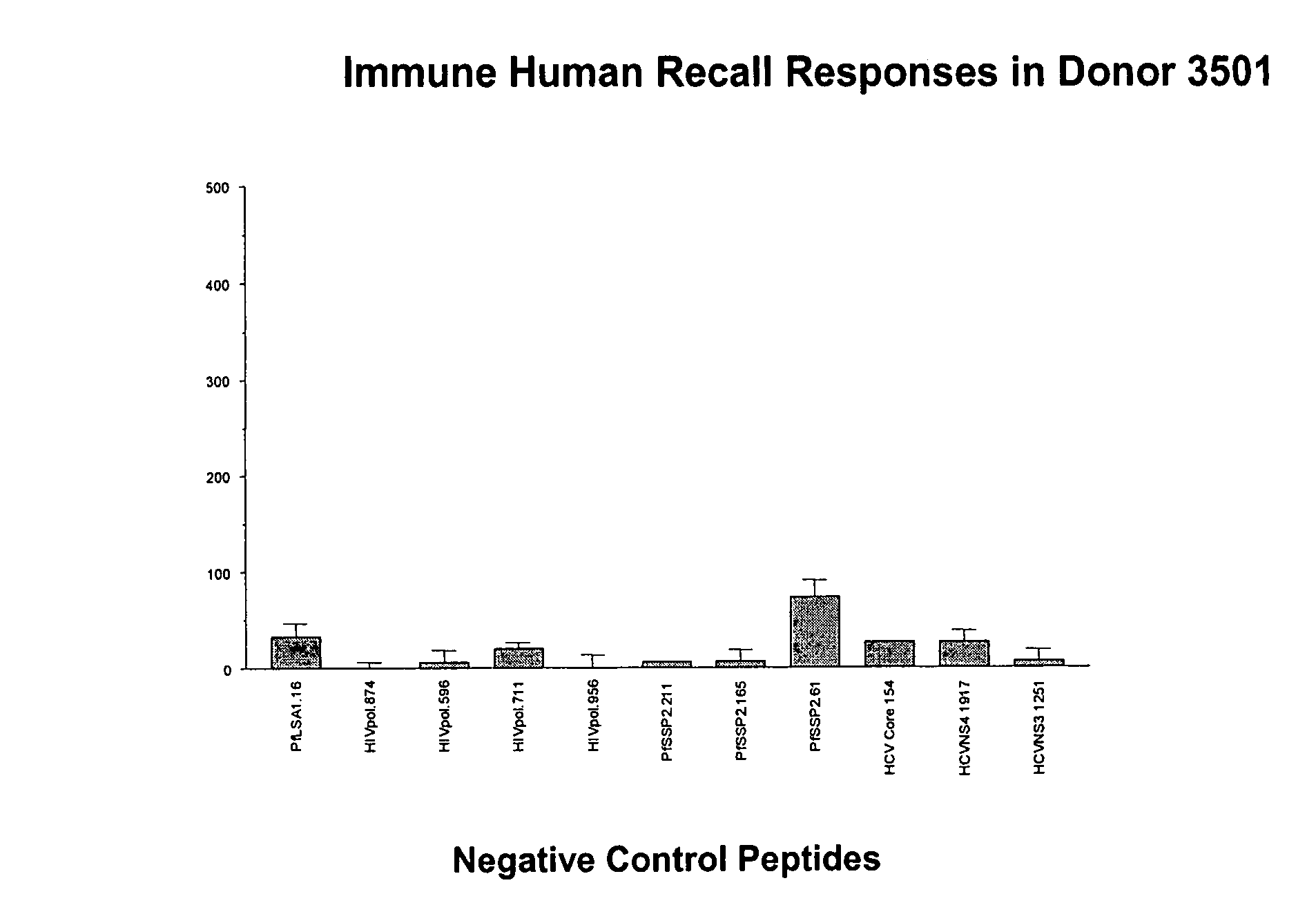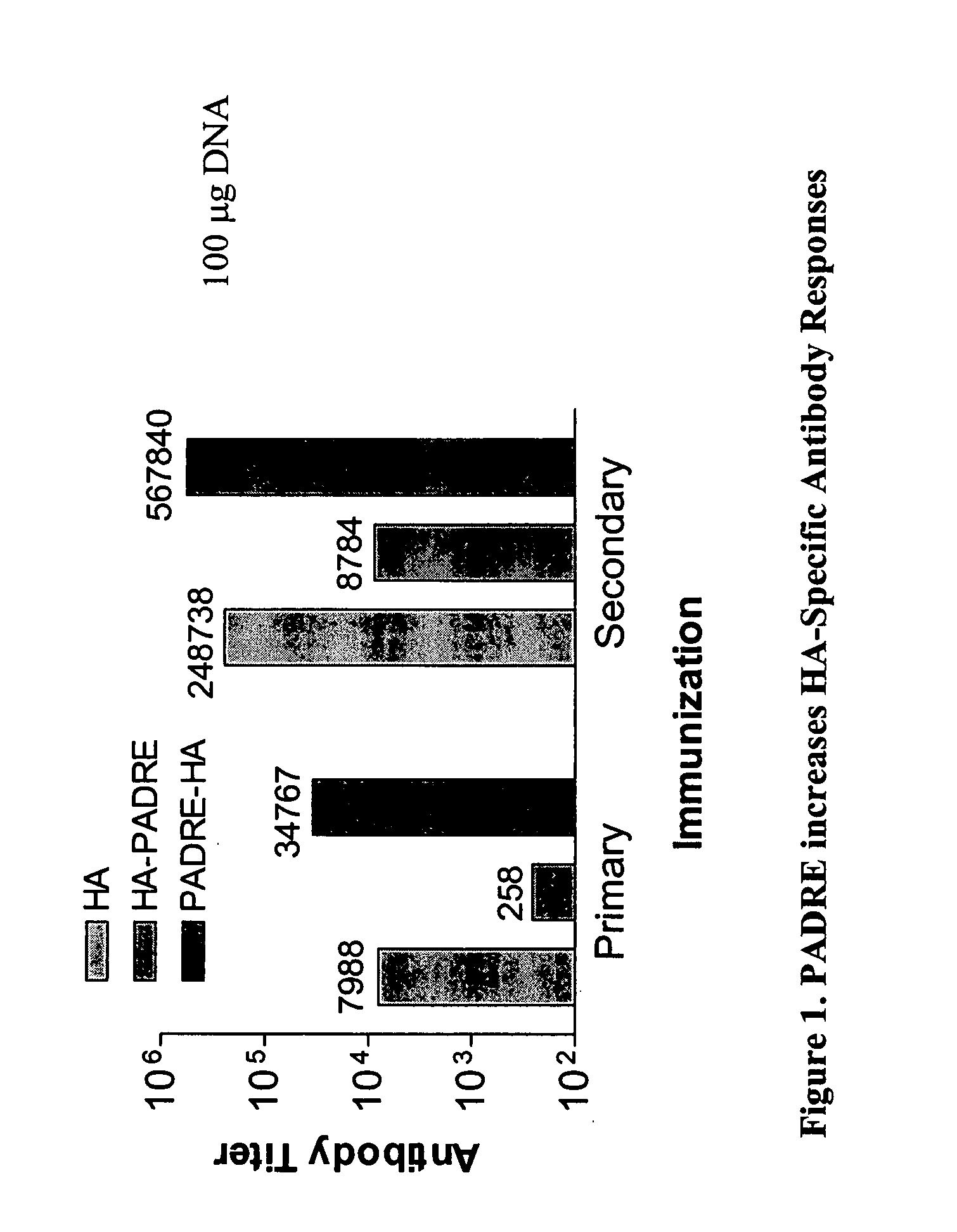Inducing immune responses to influenza virus using polypeptide and nucleic acid compositions
- Summary
- Abstract
- Description
- Claims
- Application Information
AI Technical Summary
Benefits of technology
Problems solved by technology
Method used
Image
Examples
Example
Example 1
HA, HA-PADRE® and PADRE®-HA DNA Constructs
[0318] HA, HA-PADRE® and PADRE®-HA DNA constructs were designed as follows: the HA sequences were generated by PCR using overlapping complementary oligonucleotides encoding the H5 HA from A / Vietnam / 1203 / 2004 (Accession # AAT73274). The HA sequences were backtranslated using the codon table for Autographa Californica polyhedrovirus. Blocks with 20 nucleotide overlap were annealed together and extended in a gene synthesis reaction (94° C., 30 sec; 58° C., 30 sec; 72° C., 1 min for 5 cycles; 94° C., 30 sec; 72° C., 1 min for 10 cycles) using the proof-reading polymerase Pfu (San Diego, Stratagene). The extended blocks were amplified by PCR (94° C., 30 sec; 58° C., 30 sec; 72° C., 2 min; 30 cycles) to synthesize full-length constructs. The gel purified PCR products were cloned into pFastBac (Carlsbad, Invitrogen) or mammalian vector pMB75.6 and confirmed by sequence analysis. A PADRE® sequence was inserted at a location 5′ or 3′ to th...
Example
Example 2
Immunogenicity of HA in Transgenic Animals Using HA, HA-PADRE® and PADRE®-HA DNA Constructs
[0319] Transgenic mice (HLA-DR4) were injected with 50 III of 1 mg / ml and 0.01 mg / ml of HA, HA-PADRE® and PADRE®-HA DNA constructs in the anterior tibialis muscle of both legs. Mice were immunized two times, one month apart, with bleeds occurring 4 and 2 weeks following primary and secondary immunizations, respectively. ELISA measurements were performed using 96-well, flat-bottom plates (Immunol II, Dynatech, Boston, Mass.) coated with 1 μg recombinant hemagglutinin (Protein Sciences Corporation, Meriden, Conn.). Data are shown as antibody titers determined as the reciprocal of the serum dilution yielding 0.3 OD units (450 nM). Representative results are presented in FIG. 1, where the PADRE®-HA construct shows an increase in the immunogenicity of hemagglutinin as compared to HA alone and HA-PADRE®. Results of specific antibody responses at a high and a low dose in individual animals...
Example
Example 3
M2e, M2e-PADRE® and PADRES-M2e DNA Constructs
[0322] The NCBI database was searched for M2e amino acid sequences for representatives of epidemic (H1N1, H3N2), past pandemic (H1N1, H2N2, H3N2) and potential future pandemic (H5N1, H7N7, H9N2) viral strains. As shown in Table 5, a distinct pattern of conserved and varied sequences was observed. Viral strains isolated from humans exhibited the conserved sequence, SLLTEVETPIRNEWGCRCNDSSD (SEQ ID NO:15) which is proposed as a “universal” influenza vaccine. However, potential pandemic strains do not encode this conserved sequence. In contrast, a distinct pattern of sequence variation occurs in viral strains isolated from avian or swine sources, specifically at amino acid positions, 10, 13, 15, 17, and 19. For example, A / Swine / Saskatchewan / 18789 / 02 sequence varies specifically at positions 10 (I→T), position 13 (E→G), position 15 (G→E), position 17 (R→K) and position 19 (N→S) relative to the human-derived sequence. There are other...
PUM
| Property | Measurement | Unit |
|---|---|---|
| Fraction | aaaaa | aaaaa |
| Fraction | aaaaa | aaaaa |
| Temperature | aaaaa | aaaaa |
Abstract
Description
Claims
Application Information
 Login to View More
Login to View More - R&D
- Intellectual Property
- Life Sciences
- Materials
- Tech Scout
- Unparalleled Data Quality
- Higher Quality Content
- 60% Fewer Hallucinations
Browse by: Latest US Patents, China's latest patents, Technical Efficacy Thesaurus, Application Domain, Technology Topic, Popular Technical Reports.
© 2025 PatSnap. All rights reserved.Legal|Privacy policy|Modern Slavery Act Transparency Statement|Sitemap|About US| Contact US: help@patsnap.com



